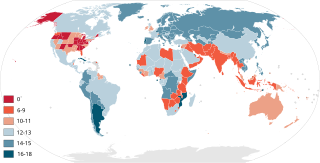
The age of criminal responsibility is the age below which a child is deemed incapable of having committed a criminal offence. In legal terms, it is referred to as a defence/defense of infancy, which is a form of defense known as an excuse so that defendants falling within the definition of an "infant" are excluded from criminal liability for their actions, if at the relevant time, they had not reached an age of criminal responsibility. After reaching the initial age, there may be levels of responsibility dictated by age and the type of offense committed.

Measure 11, also known as "One Strike You're Out", was a citizens' initiative passed in 1994 in the U.S. State of Oregon. This statutory enactment established mandatory minimum sentencing for several crimes. The measure was approved in the November 8, 1994 general election with 788,695 votes in favor, and 412,816 votes against.

Juvenile delinquency, also known as juvenile offending, is the act of participating in unlawful behavior as a minor or individual younger than the statutory age of majority. These acts would otherwise be considered crimes if the individuals committing them were older. The term delinquent usually refers to juvenile delinquency, and is also generalised to refer to a young person who behaves an unacceptable way.

The Juvenile Delinquents Act, SC 1908, c 40 was a law passed by the Parliament of Canada to improve its handling of juvenile crime. The act established procedures for the handling of juvenile offenses, including the government assuming control of juvenile offenders. It was revised in 1929 and superseded in 1984 by the Young Offenders Act.
Criminal psychology, also referred to as criminological psychology, is the study of the views, thoughts, intentions, actions and reactions of criminals and suspects. It is a subfield of criminology and applied psychology.

Recidivism is the act of a person repeating an undesirable behavior after they have experienced negative consequences of that behavior, or have been trained to extinguish it. Recidivism is also used to refer to the percentage of former prisoners who are rearrested for a similar offense.
Sex differences in crime are differences between men and women as the perpetrators or victims of crime. Such studies may belong to fields such as criminology, sociobiology, or feminist studies. Despite the difficulty of interpreting them, crime statistics may provide a way to investigate such a relationship from a gender differences perspective. An observable difference in crime rates between men and women might be due to social and cultural factors, crimes going unreported, or to biological factors for example, testosterone or sociobiological theories). The nature or motive of the crime itself may also require consideration as a factor.

Juvenile court, also known as young offender's court or children's court, is a tribunal having special authority to pass judgements for crimes committed by children who have not attained the age of majority. In most modern legal systems, children who commit a crime are treated differently from legal adults who have committed the same offense.

The American juvenile justice system is the primary system used to handle minors who are convicted of criminal offenses. The system is composed of a federal and many separate state, territorial, and local jurisdictions, with states and the federal government sharing sovereign police power under the common authority of the United States Constitution. The juvenile justice system intervenes in delinquent behavior through police, court, and correctional involvement, with the goal of rehabilitation. Youth and their guardians can face a variety of consequences including probation, community service, youth court, youth incarceration and alternative schooling. The juvenile justice system, similar to the adult system, operates from a belief that intervening early in delinquent behavior will deter adolescents from engaging in criminal behavior as adults.
A diversion program, also known as a pretrial diversion program or pretrial intervention program, in the criminal justice system is a form of pretrial sentencing that helps remedy the behavior leading to the arrest. Administered by the judicial or law enforcement systems, they often allow the offender to avoid conviction and include a rehabilitation program to prevent future criminal acts. Availability and the operation of such systems differ in different countries.
Juvenile delinquency in the United States refers to crimes committed by children or young people, particularly those under the age of eighteen.

Race in the United States criminal justice system refers to the unique experiences and disparities in the United States in regard to the policing and prosecuting of various races. There have been different outcomes for different racial groups in convicting and sentencing felons in the United States criminal justice system. Although prior arrests and criminal history is also a factor. Experts and analysts have debated the relative importance of different factors that have led to these disparities.

In the United States, sentencing law varies by jurisdiction. The jurisdictions in the US legal system are federal, state, regional, and county. Each jurisdictional entity has governmental bodies that create common, statutory, and regulatory law, although some legal issues are handled more often at the federal level, while other issues are the domain of the states. Civil rights, immigration, interstate commerce, and constitutional issues are subject to federal jurisdiction. Issues such as domestic relations, which includes domestic violence; marriage and divorce; corporations; property; contracts; and criminal laws are generally governed by states, unless there is federal preemption.

The United States incarcerates more of its youth than any other country in the world, although reports claim China has around 600,000 juveniles imprisoned which would be more than the US, through the juvenile courts and the adult criminal justice system, which reflects the larger trends in incarceration practices in the United States. In 2010, approximately 70,800 juveniles were incarcerated in youth detention facilities alone. As of 2006, approximately 500,000 youth were brought to detention centers in a given year. This data does not reflect juveniles tried as adults. As of 2013, around 40% were incarcerated in privatized, for-profit facilities.
Raising the age of juvenile jurisdiction in the state of North Carolina has been an ongoing issue in the North Carolina General Assembly. There are currently two pieces of legislation focusing on this issue, Senate Bill 506 and House Bill 632, which seek to raise the age of jurisdiction from 16 to 18. Four members of the North Carolina House of Representatives serve as the primary sponsors and there are twenty-six co-sponsors. Most of U.S. States define an adult at 18 years old; however, North Carolina and New York define a juvenile who has committed a criminal offense as no older than 16, which places 16- and 17-year-olds in a position where they are tried as adults for any offense.

Gender responsive approach for girls in the juvenile justice system represents an emerging trend in communities and courts throughout the United States, Australia and Latin America, as an increasing number of girls are entering the juvenile justice system. A gender responsive approach within the juvenile justice system emphasizes considering the unique circumstances and needs of females when designing juvenile justice system structures, policies, and procedures.

Criminal justice reform seeks to address structural issues in criminal justice systems such as racial profiling, police brutality, overcriminalization, mass incarceration, and recidivism. Reforms can take place at any point where the criminal justice system intervenes in citizens’ lives, including lawmaking, policing, sentencing and incarceration. Criminal justice reform can also address the collateral consequences of conviction, including disenfranchisement or lack of access to housing or employment, that may restrict the rights of individuals with criminal records.

Sex offender registration and notification (SORN) laws in the United States are widely accepted, with supporters believing that disclosing the location of sex offenders residence improves the public's ability to guard themselves and their children from sexual victimization. Despite this wide public acceptance, empirical observations do not uniformly support this belief.
Jennifer Woolard is a developmental psychologist known for work within the juvenile justice system. Woolard is professor of psychology and adjunct professor of law at Georgetown University. She is involved in the Youth In Custody Practice Model Initiative at the Center for Juvenile Justice Reform at Georgetown University's McCourt School of Public Policy, which seeks to adopt evidence-based developmentally-appropriate practices within juvenile correctional institutions.

A juvenile sex crime is defined as a legally proscribed sexual crime committed without consent by a minor under the age of 18. The act involves coercion, manipulation, a power imbalance between the perpetrator and victim, and threats of violence. The sexual offenses that fall under juvenile sex crimes range from non-contact to penetration. The severity of the sexual assault in the crime committed is often the amount of trauma and/or injuries the victim has suffered. Typically within these crimes, female children are the majority demographic of those targeted and the majority of offenders are male. Juvenile sex offenders are different than adult sex offenders in a few ways, as captured by National Incident Based Reporting System: they are more likely to be committed in school, offend in groups and against acquaintances, target young children as victims, and to have a male victim, whereas they are less likely than their adult counterpart to commit rape.











